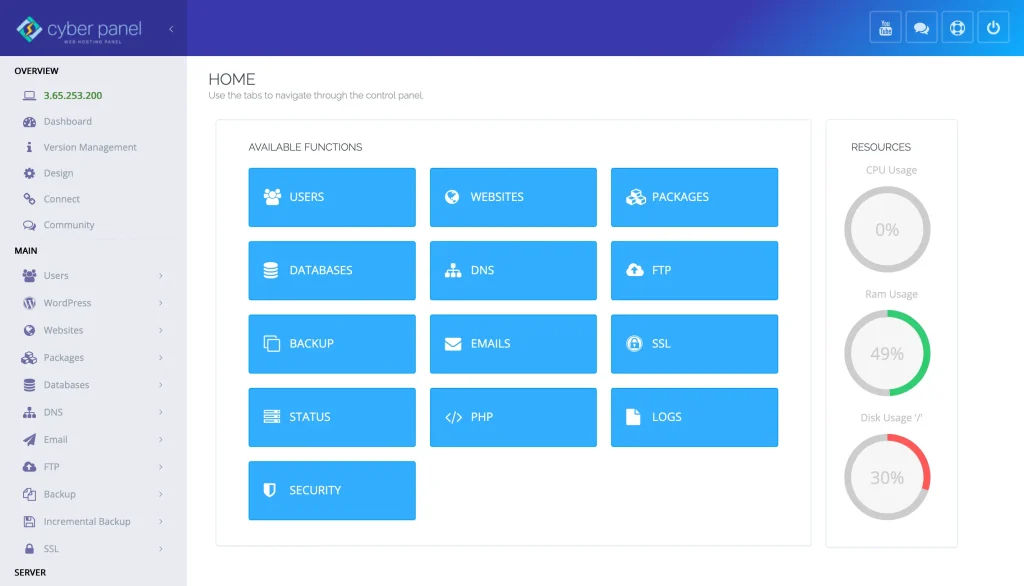Just think of your web page working, but when you’re trying to send a form, update some content or sent an API call you get greeted by a “405 Not Allowed” error. Frustrating, right? You’re not alone. The 405 status code can be one of the most frustrating errors to have to deal with because it is so vague for both the user and the developer.
This status code appears when the server does not support the facility required. In equally simple terms, you’re knocking on the right door — using the wrong key. While you may face an HTTP 405 status code issue in a REST API, CMS like WordPress or a server-side scripts, it is always better to know why it happens and how you can prevent the same and save on hours of debugging.
In this guide, we’ll explain what the 405 status code actually means, how it’s different from other types of errors such as a 403 or 404, and give you some tips on how to resolve it quickly. You’ll also discover the typical causes, the Best Practice and tools like CyberPanel that aid in diagnosing and preventing such HTTP errors.
What Is the 405 Status Code?
Method Not Allowed status code (405), this status code indicates that the HTTP method is known by the server but is not supported by the target resource. It’s not in the HTTP 1.0 spec at all and is generally caused by a server configuration issue.
Example Scenario
Attempting to POST on a URL that isn’t configured to accept it will result in a 405.
Get exclusive access to all things tech-savvy, and be the first to receive
the latest updates directly in your inbox.
What is The Difference Among 403, 404 And 405 in HTTP Status?
It differs from 403 (Forbidden) in that the server is expressly refusing the request i.e. the resource exists, but the server will not serve the requested method (405). Unlike a 403 error, the request method was valid. 403 says forget it, 404 says resource not found.
| Status Code | Meaning | Example Cause |
|---|---|---|
| 403 | Forbidden | No permission to access the URL |
| 404 | Not Found | URL does not exist |
| 405 | Method Not Allowed | Method like POST not supported |
What is The Cause for a 405 Status Code?
The major causes for HTTP 405 error are misconfigured routes, unsupported HTTP methods, or incomplete API endpoints. If you are using Apache or NGINX webservers, they may reject a method due to settings or CMS limitations.
Common Triggers
- Sending a PUT request to a GET-only endpoint
- Misconfigured
.htaccessrules - Incorrect
Allowheaders in REST APIs - CMS or plugin restrictions
How to Fix Status Code 405?
You have to check server configuration to fix status code 405. Also, make sure that the correct HTTP method is used. Moreover, do verify allowed methods for the endpoint. You can also go for debugging routing rules and review API method support.
Troubleshooting: Stepwise Explained
Check Allowed Methods:
curl -X OPTIONS https://example.com/api/
Review Server Configs:
Apache: .htaccess or AllowMethods directives
NGINX: limit_except block
Inspect Backend Logic:
Do ensure that your application supports the HTTP method in the route handler.
When Status Code: 405 Appears in APIs?
You will encounter HTTP 405 status code in REST APIs when the endpoint is valid but doesn’t support the HTTP method used. For instance, if you send a DELETE request to a read-only endpoint will trigger this error.

Tip:
Use the correct verbs (GET, POST, PUT, DELETE) based on the API documentation.
Best Practices to Prevent HTTP 405 Errors
You should implement correct routing, validate HTTP methods in your code, and ensure API documentation matches backend logic to prevent status code 405. You can also use RESTful design and automated testing.
Here are a few additional best practices:
- Use proper RESTful architecture
- Implement HTTP method fallbacks
- Validate method handling in controllers
- Use logging to trace incorrect calls
Role of CyberPanel

CyberPanel is a robust web hosting control panel. It makes error tacking simpler by:
- Providing real-time access logs
- Displaying HTTP method usage for all routes
- Allowing direct editing of .htaccess or NGINX conf files
With CyberPanel, you can quickly identify where and why the 405 error is triggered—without switching tools or waiting for a developer.
Frequently Asked Questions
What is meant by HTTP status code 405?
It means the HTTP method used in the request is not allowed for the requested resource.
Is 405 a server error or client error?
It is a client error. It indicates misuse of an HTTP method.
Can I fix 405 status code from the frontend?
Yes, you can fix it if you are using wrong method. Otherwise, there is need of backend fixes.
Wrapping Up!
To sum up, 405 status code is not as famous as a 404 or 500 status code, but it does frustrate users and developers alike. Whether you’re working in framework-level APIs or managing CMS websites, managing allowed HTTP methods is essential.
Invest in logging, streamline your routing, choose smart platforms like CyberPanel and all will remain clean from HTTP headaches.
Avoid Costly Downtime — Master HTTP Method Handling Today!



